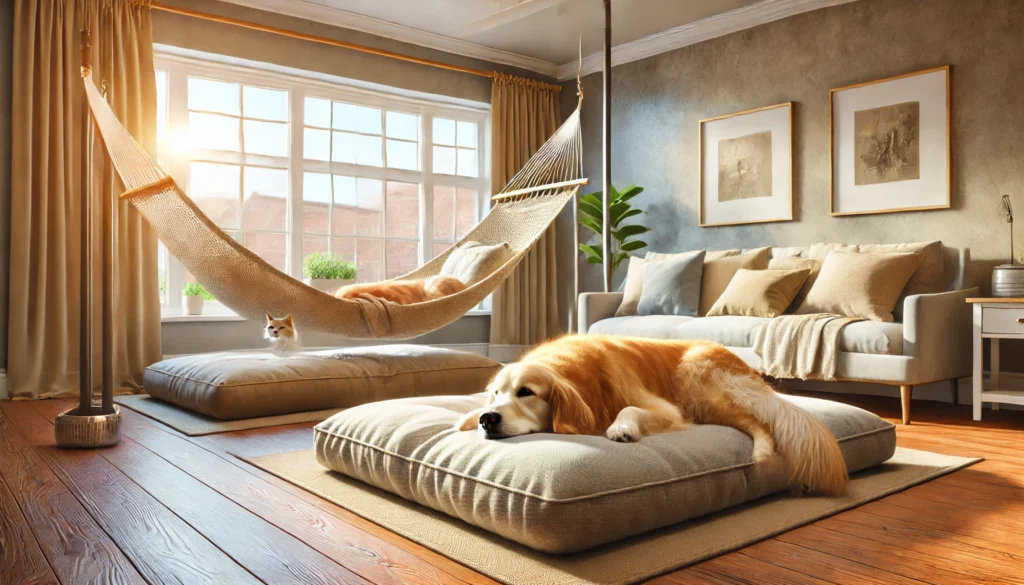Creating a cozy and supportive bed for your pet isn’t just a luxury — it’s an essential part of their physical health and emotional comfort. Dogs and cats sleep between 12 to 16 hours a day (and often more), so providing a space designed specifically for their rest needs is one of the most impactful ways to care for them.
Here’s how to make the perfect bed for your furry companion.
Why a Good Bed Matters
A well-designed pet bed can:
- Promote restful, restorative sleep
- Reduce joint strain and support growing or aging bodies
- Minimize stress and anxiety by offering a safe space
- Keep pets off furniture if you prefer boundaries
- Provide warmth and protection from cold floors
Whether your pet is a tiny kitten or a senior dog, comfort is key.
1. Choose the Right Location
Where you place the bed is just as important as what it’s made of.
- For dogs: Look for a quiet corner with low foot traffic, but where they can still observe family activity if they like to stay near you.
- For cats: Elevated areas or cozy window perches are ideal. Cats love warm, high-up, and quiet places.
- Avoid placing the bed near noisy appliances, drafty doors, or litter boxes.
Watch where your pet naturally naps — that spot might be the perfect location.
2. Select the Ideal Type of Bed
Not all beds are the same, and your pet’s personality and health should guide your choice.
- Flat pads or mats: Great for crates or younger pets
- Bolstered beds: Perfect for dogs and cats who like to curl up or rest their heads
- Cave-style beds: Excellent for shy or anxious pets who like to burrow
- Orthopedic beds: Ideal for senior pets or those with arthritis or joint pain
- Heated beds: Help older pets or short-haired breeds stay warm in cooler months
Tip: Observe how your pet sleeps — curled, stretched, or belly-up — and choose a shape that matches.
3. Use Comfortable, Washable Materials
The best beds combine softness with easy maintenance.
- Look for machine-washable covers
- Choose hypoallergenic fabrics to prevent irritation
- Use foam with supportive density for orthopedic benefits
- Avoid overly fluffy fabrics that trap fur or hold too much heat in warmer climates
Durable stitching and water-resistant liners add longevity and cleanliness.
4. Keep It Clean
Pets care about cleanliness — especially cats.
- Wash bedding weekly (or more often if your pet has allergies or sheds heavily)
- Vacuum the bed between washes to remove fur and dander
- Use pet-safe detergents with no harsh chemicals or strong fragrances
- Let the bed air-dry in the sun when possible to eliminate odors naturally
A clean bed supports a healthy coat and helps control allergens in the home.
5. Provide Multiple Resting Spots
If space allows, offer more than one cozy place to sleep.
- A bed in a social area (like the living room)
- A quiet retreat (like your bedroom or office corner)
- A sunny spot by the window (especially for cats)
- A backup bed for when one is being cleaned
This gives your pet options and helps them feel in control of their space.
6. Adjust Beds Seasonally
Your pet’s comfort needs change with the weather.
- In summer: Use breathable, moisture-wicking fabrics like cotton or mesh
- In winter: Switch to warm fleece covers or beds with thermal insulation
- Cooling mats or gel inserts can help pets beat the heat
- Avoid placing beds in direct sunlight for extended periods, especially in summer
Stay attuned to your pet’s behavior — are they avoiding the bed? It may be too hot or cold.
7. Create Positive Associations
Help your pet view their bed as a safe, relaxing haven.
- Place their favorite toy or blanket on the bed
- Offer treats or praise when they use the bed
- Avoid using the bed for time-outs or punishment
- Let your pet approach and use it on their own terms
Positive reinforcement builds trust and comfort.
8. Special Considerations for Senior or Special-Needs Pets
Older pets or those with mobility challenges need extra support.
- Use orthopedic memory foam beds
- Keep beds low to the ground for easy access
- Place beds near food, water, and litter trays for convenience
- Use non-slip mats underneath to prevent sliding on tile or hardwood floors
Supportive beds help reduce pain and improve mobility over time.
Final Thoughts: A Comfortable Bed = A Happier Pet
Providing a comfortable, clean, and well-placed bed is one of the simplest yet most powerful ways to improve your pet’s daily life. It shows them they have a space of their own — one that is safe, calming, and always waiting for them.
Take note of your dog or cat’s habits, adapt the setup with the seasons, and most importantly, offer the same love and comfort in their resting area as you do everywhere else.






